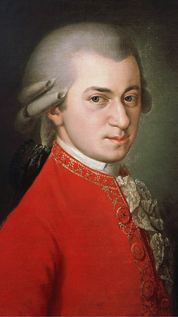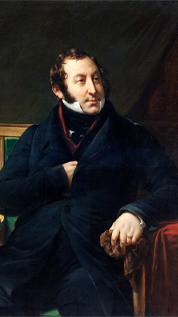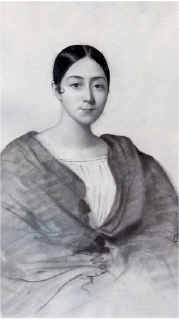
W.A. Mozart - Piano, Violin
Wolfgang Amadeus Mozart (27 January 1756 – 5 December 1791) was a prolific and influential composer of the Classical period. Despite his short life, his rapid pace of composition resulted in more than 800 works representing virtually every Western classical genre of his time. Many of these compositions are acknowledged as pinnacles of the symphonic, concertante, chamber, operatic, and choral repertoire. Mozart is widely regarded as being one of the greatest composers in the history of Western music, with his music admired for its "melodic beauty, its formal elegance and its richness of harmony and texture". Born in Salzburg, then in the Holy Roman Empire and currently in Austria, Mozart showed prodigious ability from his earliest childhood. At the age of five he was already competent on keyboard and violin, he had begun to compose, and he performed before European royalty. His father took him on a grand tour of Europe and then three trips to Italy. At 17, he was a musician at the Salzburg court but grew restless and travelled in search of a better position. While visiting Vienna in 1781, Mozart was dismissed from his Salzburg position. He stayed in Vienna, where he achieved fame but little financial security. During his final years there, he composed many of his best-known symphonies, concertos, and operas. His Requiem was largely unfinished at the time of his death at the age of 35, the circumstances of which are uncertain and much mythologised.

Gioachino Rossini - Violin
Gioachino Rossini (29 February 1792 – 13 November 1868) was an Italian composer who gained fame for his 39 operas, although he also wrote many songs, some chamber music and piano pieces and some sacred music. He set new standards for both comic and serious opera before retiring from large-scale composition while still in his thirties, at the height of his popularity. Born in Pesaro to parents who were both musicians (his father a trumpeter, his mother a singer), Rossini began to compose by the age of twelve and was educated at music school in Bologna. His first opera was performed in Venice in 1810 when he was 18 years old. In 1815 he was engaged to write operas and manage theatres in Naples. In the period 1810–1823, he wrote 34 operas for the Italian stage that were performed in Venice, Milan, Ferrara, Naples and elsewhere; this productivity necessitated an almost formulaic approach for some components (such as overtures) and a certain amount of self-borrowing. During this period he produced his most popular works, including the comic operas L'italiana in Algeri, Il barbiere di Siviglia (known in English as The Barber of Seville) and La Cenerentola, which brought to a peak the opera buffa tradition he inherited from masters such as Domenico Cimarosa and Giovanni Paisiello. He also composed opera seria works such as Tancredi, Otello and Semiramide. All of these attracted admiration for their innovation in melody, harmonic and instrumental colour, and dramatic form. In 1824 he was contracted by the Opéra in Paris, for which he produced an opera to celebrate the coronation of Charles X, Il viaggio a Reims (later cannibalised for his first opera in French, Le comte Ory), revisions of two of his Italian operas, Le siège de Corinthe and Moïse, and in 1829 his last opera, Guillaume Tell.

Giuseppe Verdi - Piano
Giuseppe Fortunino Francesco Verdi (9 or 10 October 1813 – 27 January 1901) was an Italian composer best known for his operas. He was born near Busseto to a provincial family of moderate means, receiving a musical education with the help of a local patron, Antonio Barezzi. Verdi came to dominate the Italian opera scene after the era of Gioachino Rossini, Vincenzo Bellini, and Gaetano Donizetti, whose works significantly influenced him. In his early operas, Verdi demonstrated sympathy with the Risorgimento movement which sought the unification of Italy. He also participated briefly as an elected politician. The chorus "Va, pensiero" from his early opera Nabucco (1842), and similar choruses in later operas, were much in the spirit of the unification movement, and the composer himself became esteemed as a representative of these ideals. An intensely private person, Verdi did not seek to ingratiate himself with popular movements. As he became professionally successful, he was able to reduce his operatic workload and sought to establish himself as a landowner in his native region. He surprised the musical world by returning, after his success with the opera Aida (1871), with three late masterpieces: his Requiem (1874), and the operas Otello (1887) and Falstaff (1893). His operas remain extremely popular, especially the three peaks of his 'middle period': Rigoletto, Il trovatore and La traviata. The bicentenary of his birth in 2013 was widely celebrated in broadcasts and performances.

Vincenzo Bellini - Piano
Bellini is considered one of the greatest "lyrical melodists", having influenced Chopin. His musical personality can hardly be confined within a historical-stylistic framework. While remaining faithful to the musical concepts inherited from the great composers who preceded him, Bellini is a firm believer in the primacy of song. However, as early as La straniera, Stendhal emphasized the stylistic break with Rossini's attempt to renew the forms of Baroque opera, with Bellini participating, following in the footsteps of Cherubini and Spontini, in the promotion of a "classical" style. Gifted with a prodigious melodic genius, he devoted his life to composition, and shone in the art of creating melodies of perfect limpidity. Some critics criticized his "lightness" of accompaniment. His harmonies and orchestrations were simple, but he excelled in expressing tender, melancholy sentiments. In Milan and then Paris, he brought the aura of ancient Mediterranean culture that Europe had idealized in classicism. Wagner was so enthusiastic about this revival that he chose Sicily as the setting for his opera Das Liebesverbot, oder Die Novize von Palermo, adopting the clarity of Bellini's lyrical language.

Maria Malibran - Vocals
For posterity, "La" Malibran is the epitome of the Romantic diva. Daughter of Andalusian tenor Manuel Garcia, creator of the role of Almaviva in The Barber of Seville, Maria was born in Paris, on the rue de Condé. Her voice was uneven and rebellious at first, but she mastered it thanks to her father's determination. But the violence of her father's strict upbringing marred their relationship for a long time to come. At the age of 17, her meeting in London with the last operatic castrato, Velluti, marked the clash of two worlds: the dying world of the castrato and the new era of the romantic diva. In New York, where the Garcia troupe was introducing Rossini's operas and premiering the original version of Mozart's Don Giovanni, Maria married Eugène Malibran. She separated from him after nineteen months, but would carry his name forever on the stages of Europe. Thanks to her family connections, Maria resumed her career in Paris at the age of 20. She triumphed at the Théâtre-Italien and won the admiration of Chopin, George Sand, Lamartine and Musset. With her expansive coloratura contralto voice, she aroused admiration in the Rossinian roles of Rosina and Desdemona. It was then that she fell in love with the Belgian violinist Charles de Bériot, whom she married in 1836 after the annulment of her first marriage. From 1832 to 1836, she divided her time between England and Italy. In Naples, Milan and Venice, she scored her greatest successes with Rossini and Bellini (Norma and La Somnambule). In the city of the Doges, she saved an old theater from bankruptcy, and on the very night she sang there, it was renamed the Teatro Malibran. The singer was hailed everywhere, as was the incomparable tragedienne who made every performance a new event.